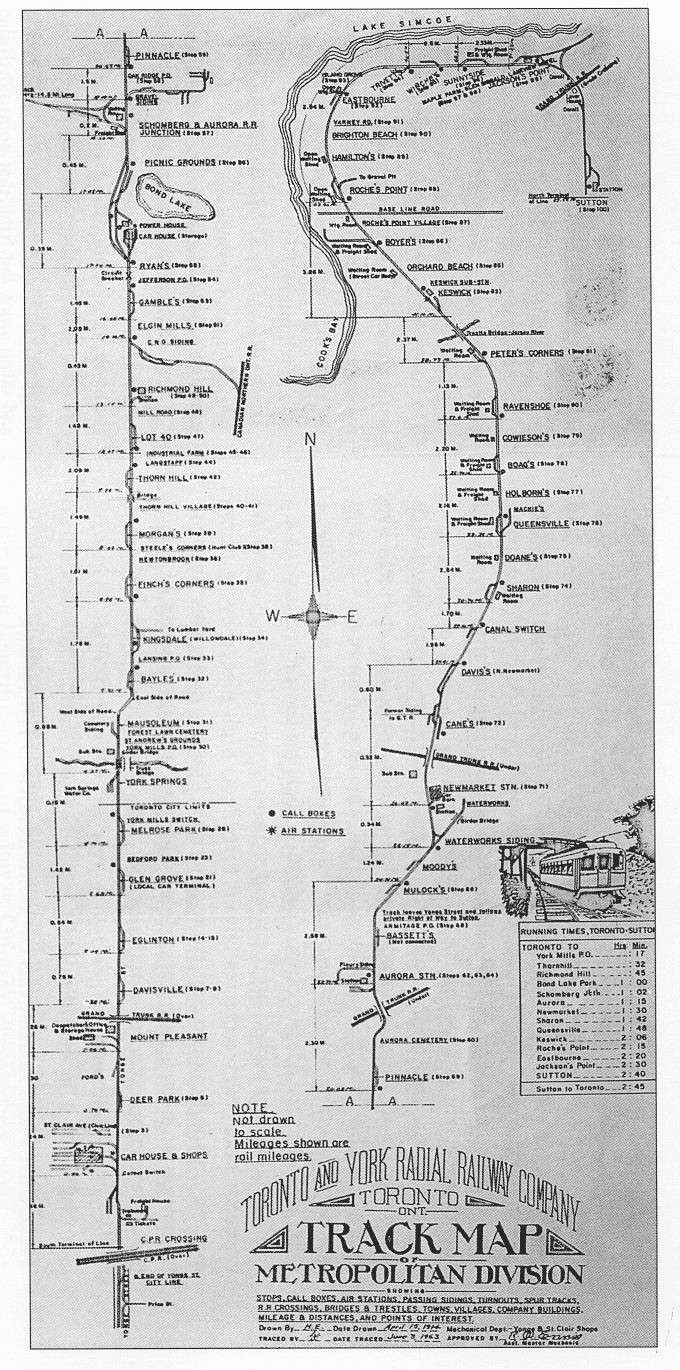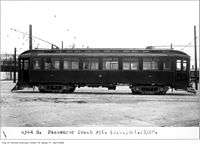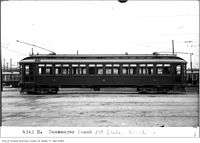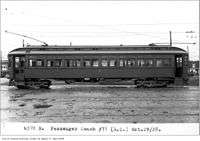Metropolitan Street Railway (Toronto)
.jpg) Metropolitan line on Yonge Street at Sherwood Avenue looking south (1912) | |
| Locale | Toronto |
|---|---|
| Dates of operation | 1885[1]–1930 |
| Successor | North Yonge Railways |
| Track gauge |
1885-1895?: 4 ft 10 7⁄8 in (1,495 mm) 1895?-1927: 4 ft 8 1⁄2 in (1,435 mm) 1927-1930: 4 ft 10 7⁄8 in (1,495 mm) |
| Length | 77 km (48 mi)[2] |
| Headquarters | Toronto |
The Metropolitan Street Railway was the operator of the Metropolitan line in the Toronto area that started out as a local horsecar line and transformed itself into an electric radial line extending to Lake Simcoe. In 1904, the railway was acquired by the Toronto and York Radial Railway (T&YRR) and became the T&YRR Metroplolitan Division. In 1922, the City of Toronto acquired the T&YRR and contracted Ontario Hydro to manage the four T&YRR lines including the Metropolitan. In 1927, the TTC took over the operation of the Metropolitan Line to Sutton, and renamed it the Lake Simcoe line. In 1930, the TTC closed the Metropolitan Line but shortly reopened the portion between Glen Echo and Richmond Hill operating it as the North Yonge Railways until 1948.
This article is more about the Metropolitan line than about the company that spawned it.
Description of the line
The Metropolitan line was a single-track radial line with passing loops. Between 1909 and 1914, the Metropolitan line was at its maximum length running from the CPR crossing at Yonge Street to Sutton. Here is a description of the line during that period.
The Toronto terminal of the Metropolitan line was on Yonge Street at the north side of the CPR crossing which at that time was a level crossing. This is near what is now the Summerhill subway station. Passengers arriving from the south by the Yonge streetcar line, needed to get off on the south side of the CPR crossing and walk across the CPR tracks to board the radial cars.[1] A 1905 photo showed that the terminal was off-street at the south-west corner of Yonge Street and Birch Avenue. However, a 1914 map showed that the terminal was relocated to the east side of Yonge Street.
From its Toronto terminal, the line ran northwards on the west side of Yonge Street until the northern brim of Hogg's Hollow. Just south of Saint Clair Avenue, the line passed the line's carhouse on the west side. At Davisville, the railway had an electrical generation station. At the southern brim of Hogg's Hollow, the line descended a 8% grade.[3][4] (In 1922, the southern terminal would be at Glen Echo at that southern brim.)
From the northern brim of Hogg's Hollow, the line crossed from the west side of Yonge Street to run along its east side for another 19 mi (31 km) except for the sections through Richmond Hill and Aurora in the centre of the street.[5] In Richmond Hill, the radial station was on the north-east corner of Yonge Street and Lorne Avenue, and passengers boarded radial cars in the street in front of the station. At the south-west edge of Bond Lake on the east side of Yonge Street, there were a carhouse and a power station. On the north side of Bond Lake was Bond Lake Park, a major source of excursion traffic for the line. Between Bond Lake and Aurora, there was a junction with the Schomberg and Aurora Railway which was a steam railway until 1916 when it was electrified.[4]
At Mulock's Corners, the line left Yonge Street to continue cross-country to Newmarket where the line ran a short distance in an alley west of Main Street. The Newmarket radial station was on Botsford Street across from the old town hall, with the track running along the town hall's west side. (In 1904, the line ran in the centre of Main Street Newmarket, but was relocated to the alley in 1905.)[6]
At about Queen Street in Newmarket, the line continued north cross-country through Sharon, Keswick and Jackson's Point to Sutton, the line's northern terminus. Between Keswick and Jackson's Point, it ran parallel to Metro Road and the shores of Lake Simcoe, often within view of the lake.[6]
The average operating speed was 32 km/h (20 mph).[4] (As a comparison, the average speed of the subway Line 2 Bloor–Danforth is also 32 kilometres per hour (20 mph).[7])
Timeline
Pre-T&YRR era (1885-1904)
- Events prior to the merger creating the Toronto and York Radial Railway in 1904
In 1877, the franchise was granted to the Metropolitan Street Railway of Toronto. The president was Robert Jaffray.[1]
In 1880, brothers Charles and W.A. Warren bought a controlling interest in the Metropolitan Street Railway.[1]
On January 26, 1885, the railway started a horsecar line on Yonge Street between the crosstown CPR rail line (near today's Summerhill Station) north to Eglinton Avenue.[8] The line was single track laid to Toronto gauge, and used double-ended cars to avoid turning loops. At the CPR line passengers could transfer to the horsecars of the Toronto Street Railway.[1]
On September 1890, electric service began on the Metropolitan Street Railway. However, horse-drawn buses were temporarily substituted circa October 1890 to May 1891.[8] The faster, heavier electrical trams had damaged the tracks forcing a rebuild of the line.[1]
In 1892, the Metropolitan line reached York Mills South (today's Glen Echo Road and location of the future Glen Echo loop).[1]
In 1893, the company's name was changed from the Metropolitan Street Railway of Toronto to the Metropolitan Street Railway Company (MStRyCo).[8]
In 1895, the province granted the railway the right to build lines in York and Simcoe counties, to use any gauge and motive power of its choice, and to make agreements with other railways (steam or electric) for connections, running rights and the interchange of cars.[3] The railway would choose standard gauge.
On February 1, 1897, the Metropolitan line was opened to Richmond Hill ending at a station located on Yonge Street at Lorne Avenue. Each one-way trip between the Toronto terminal (at the CPR crosstown line) to Richmond Hill took 45 minutes (versus 3 hours for the stagecoach), and there were 4 round trips per day.[3] (In 2016, Triplix, a regional trip planner, shows that the same trip from Summerhill subway station to Lorne Avenue in Richmond Hill using the subway and Viva would take a little over an hour.)
In 1997, the company's name changed again from the Metropolitan Street Railway Company to the Metropolitan Railway Company.[8] With the extension to Richmond Hill, the line was now more a radial line than a street railway.[3]
By 1899, the Metropolitan line was extended to Aurora and Newmarket.[8] Approaching Newmarket, the line left Yonge Street at Mullock's Corners, crossed fields along the route of the present Cane Parkway and William Street, crossed Eagle Street and proceeded north on Main Street to its terminal at Timothy Street. To support this extension, the company built a steam powerhouse at Bond Lake with a capacity of almost 1,000 horsepower.[3] A trip between Toronto and Newmarket took 90 minutes.[6]
In 1899, the railway acquired 200 acres of lakeshore land to create Bond Lake Park and generate passenger traffic for the Metropolitan line. During the 1901 season, there were 60,000 park visitors.[6]
In 1902, the Metropolitan Railway Company acquired the then unfinished Schomberg and Aurora Railway.[6]
Mackenzie & Mann era (1904-1921)
- Events when the Toronto and York Radial Railway was under the control of William Mackenzie and Donald Mann
On August 1, 1904, the Metropolitan Street Railway and the Schomberg and Aurora Railway were merged into the Toronto and York Radial Railway both becoming part of its Metropolitan Division.[9]
In 1905, the T&YRR relocated tracks in Newmarket from Main Street to a route running via sidestreets and lanes to a new station on Botsford Street opposite the town hall. The new station was equipped with freight sheds and later stationmaster's quarters on the second floor.[3]
On June 1, 1907, the T&YRR opened a 40 km (25 mi) extension of the Metropolitan line from Newmarket to Jackson's Point.[9]
On January 1, 1909, the T&YRR opened a 2.4 km (1.5 mi) extension of the Metropolitan line from Jackson's Point to Sutton.[9] The Metropolitan line was now at its maximum extent.

In 1912-1913, the T&YRR partially constructed a diversion line 100 feet (30 m) west of Yonge Street from Farnham Avenue to the CPR crosstown line in the Town of North Toronto, and then abandoned the project. The T&YRR had laid double-track from Farnham Avenue and Yonge Street south to Walker Avenue with a crossover north of Walker. Starting in 1911, there was a dispute between the T&YRR and the town, which wanted a double-track line but objected to its being on a private right-of-way crossing multiple sidestreets at grade. The railway did not want to build a double-track line on Yonge Street, one reason being it would have to pay the town $600 per mile per track. In 1912, North Toronto voters relieved the railway of the requirement for double track. A legal decision at Osgoode Hall overrode the permission the Ontario Rail Board gave to the railway to build the diversion. However, after the Town of North Toronto was annexed by the City of Toronto in 1912, the dispute over double track continued between the railway and the city.[10]
On June 25, 1915, a City of Toronto work team ripped up the tracks of the Metropolitan Line along Yonge Street from the CPR crosstown line north to Farnham Avenue. This was a result of a dispute between the city and the "Mackenzie-Mann traction companies" which included the Toronto Railway Company as well as the T&YRR. This was the first contraction of the T&YRR. Until 1916, passengers had to walk 400 metres (1,300 ft) to transfer between the radial and city cars on Yonge Street.[11]
In 1916, electrification of the Schomberg and Aurora Branch was completed.[9] Some S&A cars operated through to Toronto via the Metropolitan line, but most made connections at Bond Lake.[2]
Hydro Electric era (1922-1927)
- Events when the Toronto and York Radial Railway was managed by Hydro-Electric Railways
On August 16, 1922, the City of Toronto formally acquired the T&YRR lines. The plan was that the city portions of the T&YRR radial lines would be incorporated into the TTC, and the portions outside the city would be managed by Ontario Hydro as the Hydro-Electric Railways: Toronto and York Division.[12]
On November 1, 1922, Hydro-Electric Railways took over operation of the T&YRR lines outside of the city limits.[8] Hydro initiated a number of line improvements including track rehabilitation, a new station at Schomberg Junction, new waiting shelters, more passing sidings and additional service to Thornhill and Bond Lake Park.[12]
On November 2, 1922, the TTC opened the Yonge streetcar line to the city limits at Glen Echo. The old standard-gauge, single-track Metropolitan line along the west side of Yonge Street from Farnham Avenue was replaced by a new double-track, centre-of-the-road streetcar line.[12]
In March 1923, Glen Echo terminal was opened at the city limit at Yonge Street and Glen Echo Road. The terminal had a two-storey, buff-coloured building with Spanish roof tiles. The building had passenger and baggage facilities on the first floor and offices on the second. There was a nine-metre wide platform between the radial and streetcar tracks to facilitate transfers.[12]
TTC era (1927-1948)
- Events when the TTC operated the Toronto and York Radial Railway lines
On January 12, 1927, the Toronto Transportation Commission started operating the T&YRR lines under contract. This included the Metropolitan line which the TTC renamed as the Lake Simcoe line.[12]
In June 1927, the Schomberg and Aurora line was closed.[8]
Between September 11–17, 1927, the TTC changed the Lake Simcoe line from standard gauge to Toronto gauge.[5] The TTC also closed the Glen Echo shops and carhouse, and moved their function to the Eglinton Division carhouse. With the gauge conversion, it was possible to run radial cars into downtown Toronto, but except for night express cars and excursions to Bond Lake Park, the TTC took little advantage of this.[12]
After the 1929 season, Bond Lake Park permanently closed.[5]
On March 16, 1930, the TTC closed the Lake Simcoe (formerly Metropolitan) line as the line had been losing money for years. Road competition was the major factor. Between 1925 and 1930, auto and truck traffic increased along Yonge Street from 4,925 to 11,163 per day, and bus traffic increase from 2 to 188 per day.[12]
Postscript
On July 17, 1930, the TTC reopened a portion of the defunct Lake Shore line between Richmond Hill and Toronto as the North Yonge Railways. This line was owned by area municipalities and operated under contract by the TTC.[8]
On October 9, 1948, service was terminated on the North Yonge Railways, the last surviving Toronto radial.[8]
Stops
| Track map of Metropolitan Division, 1914 |
|---|
 |
| Metropolitan line stops south to north prior to 1922[13] |
|---|
|
Stops renumbered from Glen Echo Terminal after 1922
Facilities
Here is a list of Metropolitan line facilities from south to north in 1926:[5]
- Glen Echo terminal
- Glen Echo Carhouse and Freight Shed
- York Mills - substation
- Bond Lake Park Carhouse and power house
- Newmarket Carhouse
- Sharon - freight station
- Sedore - substation
- Camps - freight houses
In 1914, there was also a carhouse on the west side of Yonge Street south of Saint Clair Avenue. (See 1914 map).
Freight service
Standard gauge era (1895?-1927)
_(14761032662).jpg)
Once the Metropolitan line converted to standard gauge, it could interchange carload freight with steam railways, which it did with the CNR. Carload freight accounted for 10-15% of the line's revenue for many years. There was also milk traffic and train loads of ice from Lake Simcoe.[2]
Toronto gauge era (1927-1930)
With the change of the Metropolitan line to Toronto gauge, express motors and trailers carrying less-than-car load freight and produce were run into downtown Toronto. The TTC converted the former TRC shops on Sherbourne Street into a freight terminal. There were 4 round trips per day from Sutton. Express service ended in 1930 with the closure of the Lake Simcoe line.[5]
The TTC continued a standard-gauge freight service between the CNR and Collis Leather in Aurora. To do this, the TTC laid 3 km (1.9 mi) of four-rail, dual-gauge track. The TTC stationed a former passenger car there for standard-gauge shunting.[5]
Fleet
This section describe a few of the cars used on the line.
1906-1907 purchase
The T&YRR purchased 15 new dark-green radial cars in 1906-1907 for the Metropolitan line.[9] According to a 1907 article in The Railway and Marine World, the cars had the following features:
- Seating for 24 passengers in the smoking section, 38 passengers in the main section.
- Equipped with lavatory, drinking-fountain, hat-racks, coat-hooks.
- Powered by four 75 h.p. motors giving each car 300 h.p.
- Maximum speed of 50 mi (80 km) per hour.
- Multiple-unit control by one motorman.
- Car length of 55 ft. 7 in., width of 9 ft. 3 in.
TTC radial cars
The TTC inherited several series of radial cars from the Hydro-Electric Railways in 1927. Here is a description of a few of those cars, all of which were double-ended.[5]
| Car numbers |
Builder | Year built |
Comments | Image |
|---|---|---|---|---|
| 51,52 | Southern Car Company | 1906 | Purchased in 1909 from the Norwich and Westerly Railway, Norwich, Connecticut. |  |
| 53,54,56,58,60 | Toronto Railway Company | 1906 |  | |
| 68,70,72,74,76,78 | Toronto Railway Company | 1907 |  |
TTC streetcars
In early 1928, the TTC modified 7 double-ended ex-TCR cars 2160-2166, 23 single-ended Peter Witt cars 2500-2522 and 4 six-motor trains 1244/1170-1250/1176 for radial service. (A six-motor train was a coupled pair of 2 ex-TRC cars, the first car having 4 motors and the second having 2.) These cars were fitted with air whistles, large-flange wheels, and flag and marker light brackets. They were mainly used to handle heavy crowds to Bond Lake. However, on one occasion, such cars (including Peter Witt cars) went all the way to Sutton to accommodate an Orangemen's picnic, where the single-ended cars were reversed on a wye at Jackson's Point.[16]
Preservation Status
Here is a list of preserved and surviving structures with stop numbering as of before 1922:
| Location | Stop | Description | Photo |
|---|---|---|---|
| Aurora | Radial railway bridge abutment to support a bridge carrying the radial line over the Grand Trunk Railway tracks south of Aurora. | | |
| Newmarket | Radial Arch: A concrete arch that supported part of a trestle to carry the radial line over Holland River and Grand Trunk Railway tracks in Newmarket.[17] | | |
| Queensville | 75 | Station moved to Queensville Sideroad as a private residence.[18] | |
| Keswick | 83 | Station on Radial Road location now a legal office.[18] | |
| Willow Beach | Station on Metro Road east of the 6th Concession now a private residence.[18] | ||
| Trivett's | 94 | Waiting shelter moved to Georgina Historical Park.[15] | |
| Winch's | 95 | Waiting shelter moved to Georgina Historical Park.[15] | |
| Sutton | 100 | Station located at Dalton and High Streets, now a real estate office.[18] It is listed as a protected structure by the Town of Georgina, protected since 2009 under Part IV of the Ontario Heritage Act. The station was built in 1908.[19] |
Image gallery
 The first radial car to Jackson's Point, 1907
The first radial car to Jackson's Point, 1907 Keswick station, ca. 1910
Keswick station, ca. 1910 Sutton station, ca. 1920
Sutton station, ca. 1920 Radial car at Bond Lake, ca. 1910
Radial car at Bond Lake, ca. 1910
References
- 1 2 3 4 5 6 7 Robert M. Stamp (1989). Riding the Radials, Toronto's Suburban Electric Streetcar Lines. The Boston Mills Press. ISBN 1-55046-008-0. Retrieved 2016-04-16.
Chapter 1 - The Spinal Cord of Yonge Street
- 1 2 3 John F. Due, University of Illinois (1966). The Intercity Electric Railway Industry in Canada. University of Toronto Press. Retrieved 2016-05-05.
Part II - The Individual Companies / Chapter Nine - Ontario / The Toronto Area Roads / Toronto and York Radial Railway Company
- 1 2 3 4 5 6 Robert M. Stamp (1989). Riding the Radials, Toronto's Suburban Electric Streetcar Lines. The Boston Mills Press. ISBN 1-55046-008-0. Retrieved 2016-04-16.
Chapter 2 - The Mighty Metropolitan Moves North
- 1 2 3 Robert M. Stamp (1991). "Rails through Richmond Hill". Richmond Hill Public Library. Retrieved 2016-09-11.
The Radial Railway Arrives
- 1 2 3 4 5 6 7 John F. Bromley (1979). TTC '28; the electric railway services of the Toronto Transportation Commission in 1928. Upper Canada Railway Society. pp. 10–12: The Radial Network; pp. 14: TTC Freight Operations; pp. 32–34: Roster of passenger cars. Retrieved 2016-05-05.
- 1 2 3 4 5 Robert M. Stamp (1989). Riding the Radials, Toronto's Suburban Electric Streetcar Lines. The Boston Mills Press. ISBN 1-55046-008-0. Retrieved 2016-04-16.
Chapter 3 - Through the Highlands of York to Bond Lake Park
- ↑ "Light Rail Transit Facts". Metrolinx. May 31, 2015. Retrieved May 31, 2015.
- 1 2 3 4 5 6 7 8 9 Wyatt, David A. "History of Regional Transit in Toronto, Ontario". Retrieved 2016-05-01.
- 1 2 3 4 5 Robert M. Stamp (1989). Riding the Radials, Toronto's Suburban Electric Streetcar Lines. The Boston Mills Press. ISBN 1-55046-008-0. Retrieved 2016-04-16.
Chapter 5 - The Toronto & York Radial Railway
- ↑ Steve Munro & John F. Bromley (11 January 2009). "North Toronto vs the T&YRR". Retrieved 2016-05-08.
- ↑ Robert M. Stamp (1989). Riding the Radials, Toronto's Suburban Electric Streetcar Lines. The Boston Mills Press. ISBN 1-55046-008-0. Retrieved 2016-04-16.
Chapter 7 - Tommy Church vs. William Mackenzie
- 1 2 3 4 5 6 7 Robert M. Stamp (1989). Riding the Radials, Toronto's Suburban Electric Streetcar Lines. The Boston Mills Press. ISBN 1-55046-008-0. Retrieved 2016-04-16.
Chapter 9 - Who Wants to Run the Radials?
- ↑ Toronto and York Radial Railway (19 May 1916). "Daily Schedule - Sutton to Toronto".
- ↑ Barbara Myrvold (1994). Historical Walking Tour of Lawrence Park. Toronto Public Library Board. pp. 12–13. ISBN 0920601227.
- 1 2 3 4 "Waiting for the Streetcar in Georgina". Georgina Pioneer Village, Keswick, Ontario. Retrieved 2016-10-14.
- ↑ John F. Bromley and Jack May (1973). 50 Years of Progressive Transit. Electric Railroaders' Association. pp. 39:Streetcars in radial service. ISBN 9781550024487. Retrieved 2016-08-31.
- ↑ "The Radial Arch". Canada's Historic Places. Retrieved 2016-10-14.
- 1 2 3 4 "The Toronto & York Radial Railway". The Ontario Railway History Page. Retrieved 2016-10-13.
- ↑ GEORGINA HERITAGE COMMITTEE (July 21, 2015). HERITAGE COMMITTEE AGENDA (PDF) (Report). Town of Georgina. Retrieved August 23, 2015.
Built 1908, "The Metropolitan Radial Railway Station"